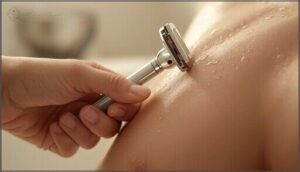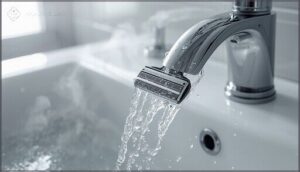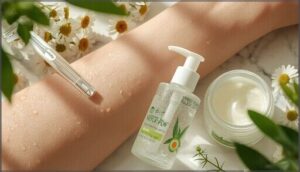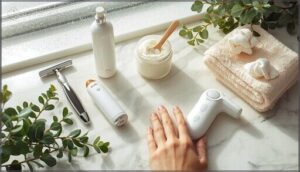This site is supported by our readers. We may earn a commission, at no cost to you, if you purchase through links.
Even the smallest routines can set the tone for how your day feels, and few things test your patience like an irritated underarm. From the burn of forgotten stubble to the sting of redness hours later, learning how to shave armpits without hassle is a tiny act of self-care that pays off every time you lift your arms.
Smooth, comfortable skin isn’t luck—it’s a series of steps that anyone can master. Whether you’re after a clean-cut look or aiming to avoid those midday itches, a few mindful choices turn shaving into a gentle ritual that fits your everyday life.
Table Of Contents
Key Takeaways
- Proper preparation—cleansing, exfoliating, softening hair with warm water, and removing deodorant—significantly reduces irritation and creates smoother shaving results.
- Using a sharp, flexible razor with short strokes in multiple directions, rinsing the blade frequently, and keeping skin taut minimizes cuts and catches stubborn hairs more effectively.
- Immediate aftercare including cool water rinses, gentle patting dry, fragrance-free moisturizer, and waiting 10-30 minutes before applying deodorant prevents redness, bumps, and ingrown hairs.
- Regular blade replacement every 5-7 shaves, maintaining clean tools, and choosing appropriate products for your skin sensitivity are essential for preventing bacterial buildup and skin darkening over time.
How to Prepare Armpits for Shaving
Getting your armpits ready before shaving makes a big difference in how your skin feels afterward. A few simple steps can help prevent irritation and give you smoother results.
Here’s what you’ll want to do before you pick up your razor.
Cleaning and Exfoliating Underarms
Starting with thorough cleansing sets the stage for better shaving outcomes. Gentle washing removes sweat, deodorant, and bacteria, supporting personal hygiene and skin health.
Exfoliation benefits go further—by clearing away dead skin cells, you lower your chances of ingrown hairs and bumps. Regular exfoliation also helps maintain microbial balance, making underarm skin care smoother and less prone to irritation. It’s important to remove those dead cells to prevent clogged pores.
Softening Skin and Hair With Warm Water
Once your underarms are clean, warm water is your best ally for a smooth shave. Soaking the armpit area for 2–3 minutes at a comfortable water temperature swells keratin, opens follicles, and triggers lipid release. You’ll notice less resistance and improved shave comfort. Warm water is ideal because it breaks down hydrogen bonds in the hair.
Here’s what works:
- Immerse underarms in warm water
- Wait at least 2 minutes
- Check water isn’t too hot
Removing Deodorant and Sweat
Once skin is softened, focus on pre-shave cleansing. Sweat and deodorant leave product residue that traps bacteria and boosts odor.
Soap alone may miss stubborn antiperspirant buildup, so consider oil-based cleansers for a deeper clean.
Removing deodorant before shaving armpits lowers bacterial populations, improves odor mitigation, and helps prevent irritation. Think of it as clearing the way for a safer shave.
Trimming Long Armpit Hair
Once deodorant is out of the way, it’s smart to trim long armpit hair before shaving. Most men—about 68%—trim for comfort or appearance. Experts suggest keeping hair at least three-fourths of an inch to avoid prickly regrowth.
Clean trimmer heads and short strokes help reduce nicks. Good hygiene and trimming first make shaving armpits smoother and safer.
Choosing The Right Tools and Products
Getting a smooth, safe shave starts with the right tools and products. The choices you make here can make all the difference for your skin. Let’s look at what you’ll want to have on hand before you begin.
Selecting a Sharp, Flexible Razor
Ever tried shaving with a dull razor? It’s like mowing wet grass—frustrating and rough. Blade sharpness matters for a smooth, safe shave, especially if you have skin sensitivity. Razor flexibility helps the blade glide over curves, reducing irritation.
Regular razor maintenance extends blade life and protects your skin. User preferences may vary, but comfort and safety always come first.
Best Shaving Gels, Creams, and Foams
Comfort starts with the right shaving gel, cream, or foam. For sensitive skin, look for ingredient benefits like shea butter or oat. Application techniques matter—spread a rich lather for even coverage. Scent preferences range from fragrance-free to cooling menthol. Cost comparison helps too:
- Pacific Shaving Shea Butter Cream ($9.99)
- Aveeno Therapeutic Gel ($4.47)
- Harry’s Foaming Gel ($11.49)
- Skintimate Shave Gel ($3.99)
Importance of Clean, Hygienic Tools
Your razor isn’t just a tool—it’s a potential hotspot for bacteria. Razor contamination risks rise quickly in humid bathrooms, with millions of microbes lurking on dull blades.
Your razor is a bacteria hotspot—millions of microbes thrive on dull blades in humid bathrooms
Infection prevention starts with cleaning protocols: rinse and dry your razor after every shave, replace blades often, and store them dry.
Good habits boost tool longevity and support public health, keeping your shaving routine safe.
Step-by-Step Armpit Shaving Technique
Getting a smooth, comfortable shave under your arms is all about the right approach.
Here’s what to keep in mind at every step. Let’s walk through what works best for most people.
Proper Shaving Direction and Strokes
Armpit hair grows every which way—it’s not one-way traffic. For best results, use short, 1- to 2-inch strokes in multiple directions, from upward to sideways to downward motion.
Aim for 12–20 strokes total, resetting your razor angle often. This multi-directional shaving technique catches stubborn hairs and protects skin health, reducing irritation and missed spots.
Holding The Razor and Skin Taut
Think of your underarm skin like a delicate canvas. Holding your skin gently taut sharpens each razor grip, bringing better stroke control and reducing irritation. Keep the angle just right—about 30 degrees is ideal. For a safer, more comfortable shave, remember:
- Avoid over-stretching
- Relax your wrist
- Grip close to the blade
- Use light, steady pressure
Rinsing The Blade Frequently
Ever notice how a clogged razor blade slows you down and stings more? Rinsing your blade every two or three strokes is a game changer for Clogging Prevention and Hygiene Impact.
This shaving tip boosts Shaving Efficiency, reduces Irritation, and extends Blade Maintenance. Warm water clears debris, keeping your razor sharp and your shaving process smooth from start to finish.
Tips for Sensitive Skin and Avoiding Cuts
Keeping your blade clean is only half the battle—sensitive skin needs extra care to avoid razor burn, ingrown hairs, and irritation.
Try these steps:
- Use hypoallergenic shaving gel for product selection.
- Glide the razor with light pressure.
- Shave in the direction of hair growth.
- Moisturize immediately as part of postshave care—this soothes and helps prevent skin irritation.
Essential Aftercare for Smooth Underarms
Taking care of your underarms after shaving is just as important as the shave itself.
A few simple steps can help keep your skin comfortable and healthy. Here’s what you’ll want to do right after you finish shaving.
Rinsing and Drying Underarms Post-Shave
After you finish shaving, rinsing underarms with cool or lukewarm water helps close pores and keeps bacteria out. Use a gentle, fragrance-free soap to clear away residue, then pat dry with a clean towel—never rub. This postshave care step aids infection prevention, odor control, and a healthy skin care routine.
Compare options below:
| Water temperature | Drying methods |
|---|---|
| Cool/lukewarm | Pat with clean towel |
| Lukewarm | Disposable tissue |
| Cool | Air dry briefly |
Moisturizing to Prevent Irritation
Once your underarms are dry, moisturize right away to lock in hydration and support barrier repair. This step is key for itch reduction and keeping skin irritation at bay. Reach for fragrance-free creams with ceramides or hyaluronic acid—these help with ingredient profiles and ingrown prevention, leaving your postshave skin care routine simple and effective.
- Hydration Importance
- Barrier Repair
- Ingrown Prevention
When to Apply Deodorant Safely
Once your skin is moisturized, pause before reaching for deodorant. A waiting period of 10–30 minutes gives your armpits time to recover, lowering immediate risks like redness or burning.
Ingredient sensitivity is common, especially with fragrances and alcohol. For preventive measures, choose gentle, fragrance-free formulas, and remember—most people benefit from waiting, even if you shave daily.
Managing Redness, Bumps, and Ingrown Hairs
Although smooth results are the goal, razor burn and bumps often sneak in. To tackle redness and ingrown hairs, focus on these three steps:
- Exfoliation Benefits: Gently exfoliate before shaving to prevent skin irritation and bumps.
- Soothing Irritation: Moisturize right after for barrier repair.
- Ingrown Solutions: Use warm compresses or topical treatments to treat stubborn ingrown hairs.
Alternatives to Shaving and Safety Tips
Shaving isn’t your only option for smooth underarms. If you’re curious about other methods or want to avoid common skin issues, there are several approaches you can try.
Here’s what you need to know before you decide what’s right for you.
Waxing, Sugaring, and Laser Hair Removal
Seeking smoother, longer-lasting results? Waxing benefits include keeping hair away for up to four weeks, but it’s not without pain and occasional irritation.
Sugaring advantages shine for sensitive skin—removing hair with less trauma and fewer ingrown issues.
If you want something more permanent, laser longevity is impressive, often reducing hair regrowth by 80–95% after several sessions.
Consider your comfort and commitment level when weighing hair removal methods.
Pros and Cons of Electric Razors and Depilatories
While electric razors offer quick, gentle shaves and are favored for comfort and skin sensitivity, they deliver less closeness, meaning hair returns faster. Depilatory creams, a pain-free alternative, smooth skin a bit longer but may trigger irritation or chemical burns on delicate areas.
User satisfaction varies—many switch between these hair removal methods, adapting to changing needs and market trends.
Preventing Common Shaving Risks and Skin Issues
Razor burn and folliculitis can sneak up on you after a quick shave, especially if you rush or skip proper prep. To prevent boils, ingrown hairs, and chemical irritation, use sharp razors and gentle shaving techniques, and avoid deodorant immediately after.
Prioritize clean tools, rinse often, and hydrate your skin—these steps are essential for preventing skin irritation, even with sensitive skin.
Trends in Armpit Hair Removal and Skin Health
Ever notice how the shaving trend decline tags along with evolving beauty standards and booming home device popularity? Social media influence invites everyone to rethink the norms around armpit hair removal, while at-home IPL gadgets promise salon results.
Still, all underarm hair removal—from shaving underarm hair to lasers—brings a temporary risk of skin inflammation, so preventing skin irritation remains essential for skin health.
Frequently Asked Questions (FAQs)
How often should I replace my razor blade?
Like milk past its prime, a dull razor just won’t do the job. Replace your razor blade every 5 to 7 shaves to avoid irritation, nicks, and bacterial buildup that compromise skin health.
Can I shave armpits with body hair clippers?
You can trim armpit hair with body hair clippers designed for sensitive areas.
Trimming reduces irritation and cuts compared to shaving, leaves hair slightly longer, and requires less frequent maintenance for personal grooming.
Does armpit shaving cause darker skin over time?
Frequent friction and micro-tears from underarm shaving can trigger hyperpigmentation, especially in darker skin types.
Using sharp razors, proper lubrication, and post-shave moisturizers greatly reduces trauma and skin darkening risk over time.
What causes ingrown hairs and how to treat?
Ingrown hairs occur when curly hair curves back into skin after shaving.
Treat them with topical treatments like salicylic acid, gentle skin exfoliation, and proper shaving techniques. Laser removal offers long-term prevention.
Is it safe to shave armpits during pregnancy?
Shaving armpits during pregnancy is generally safe when you use a fresh razor each time. However, skin sensitivity increases throughout pregnancy trimesters, and infection risks rise after 36 weeks, so prioritize hygiene practices carefully.
Conclusion
You might think shaving armpits takes too much time, but a solid routine becomes second nature. Once you know how to shave armpits with the right prep, sharp tools, and gentle aftercare, irritation fades and confidence grows.
Your underarms deserve the same attention you give the rest of your skin. Treat them well, stay consistent, and you’ll enjoy smooth, comfortable results that last—no sting, no regret, just clean comfort every day.
- https://getbevel.com/blogs/articles/armpit-grooming-101-the-dos-and-donts
- https://www.irishexaminer.com/lifestyle/healthandwellbeing/arid-41420644.html
- https://studyfinds.org/pandemic-women-shave-armpit/
- https://www.vogue.com/article/is-shaving-your-armpits-about-to-become-a-thing-of-the-past
- https://magsskin.com/blogs/magsazine/can-shaving-cause-armpit-rashes











